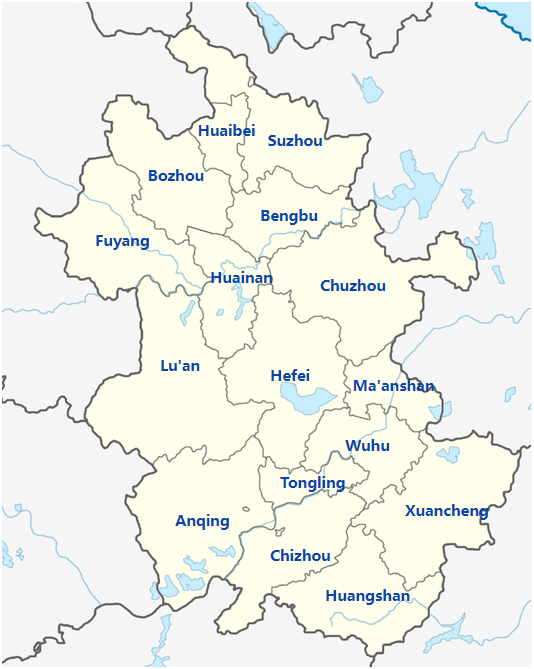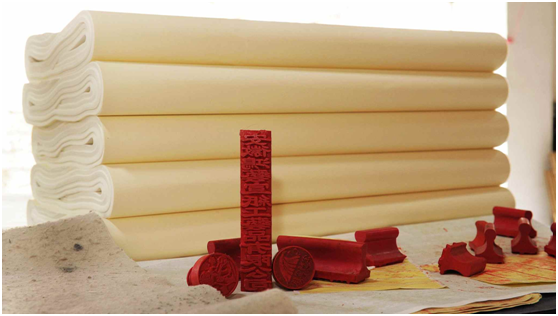 Search
Search
 Search
Search
Anhui UK: /?n?hwe?/, US: /?ɑ?n?hwe?/ (安徽; formerly romanized as Anhwei) is a landlocked province of the People's Republic of China, part of the East China region. Its provincial capital and largest city is Hefei. The province is located across the basins of the Yangtze River (aka Changjiang River) and the Huai River, bordering Jiangsu to the east, Zhejiang to the southeast, Jiangxi to the south, Hubei to the southwest, Henan to the northwest, and Shandong for a short section in the north.
With a population of 61.13 million permanent residents (2021), Anhui is the 8th most populous province in China. It is the 22nd largest Chinese province based on area, and the 12th most densely-populated region of all 34 Chinese provincial regions. Anhui's population is mostly composed of Han Chinese. Languages spoken within the province include Jianghuai Mandarin, Wu, Hui, Gan and small portion of Zhongyuan Mandarin Chinese.
The name "Anhui" derives from the names of two cities: Anqing and Huizhou (now Huangshan City). The abbreviation for Anhui is "Chinese: 皖; pinyin: wǎn" after the historical State of Wan, Mount Wan, and the Wan river.
Anhui Province was established in the sixth year of the reign of the Kangxi Emperor of the Qing dynasty (1667).Before that, there was no coherent concept of "Anhui". The province also has another name, "Wan", because, during the Spring and Autumn Period (722–481 B.C.), a small country named "Wan" was here and a mountain called "Wanshan" (aka Mount Tianzhu) is in the province.

(A Typical Hui-style Architecture Village)
Anhui is topographically diverse. The north is part of the North China Plain while the north-central areas are part of the Huai River watershed. Both regions are flat, and densely populated. The land becomes more uneven further south, with the Dabie Mountains occupying much of southwestern Anhui and a series of hills and ranges cutting through southeastern Anhui, between which is the Yangtze River. The highest peak in Anhui is Lotus Peak, part of Huangshan in southeastern Anhui. It has an altitude of 1873 m.

(World Heritage Site: Mount Huangshan)
Major rivers include the Huai River in the north and the Yangtze in the south. The largest lake is Lake Chaohu situated in the center of the province, with an area of about 800 km2 (310 sq mi). The southeastern part of the province near the Yangtze River has many lakes as well.
Anhui spans many geographical and cultural regions. The northern, flatter parts of the province, along the Huai River and further north, are most akin to neighboring provinces like Henan, Shandong and northern Jiangsu. In contrast, the southern, hilly parts of the province are more similar in culture and dialect to other southern, hilly provinces, like Zhejiang and Jiangxi.

(Administrative Divisions of Anhui)
Mandarin dialects are spoken over the northern and central parts of the province, north of the Yangtze River. Dialects to the north (e.g. Bengbu dialect) are classified as Zhongyuan Mandarin, together with dialects in provinces such as Henan and Shandong; dialects in the central parts (e.g. Hefei dialect) are classified as Jianghuai Mandarin, together with dialects in the central parts of neighboring Jiangsu province. Non-Mandarin dialects are spoken to the south of the Yangtze: dialects of Wu are spoken in Xuancheng prefecture-level city, though these are rapidly being replaced by Jianghuai Mandarin; dialects of Gan are spoken in a few counties in the southwest bordering Jiangxi province; and the Huizhou dialects are spoken in about ten counties in the far south, a small but highly diverse and unique group of Chinese dialects.
Huangmei Opera, which originated in the environs of Anqing in southwestern Anhui, is a form of traditional Chinese opera popular across China. Huiju, a form of traditional opera originating in the Huizhou-speaking areas of southern Anhui, is one of the major precursors of Beijing Opera; in the 1950s, Huiju (which had disappeared) was revived. Luju is a type of traditional opera found across central Anhui, from east to west.
Anhui cuisine is one of the eight great traditions of Chinese cuisine. Combining elements of cooking from northern Anhui, south-central Anhui, and the Huizhou-speaking areas of southern Anhui, Anhui cuisine is known for its use of wild game and herbs, both land and sea, and comparatively simple methods of preparation.

(Mandarin Fish: a representative dish of Anhui Cuisine)
Anhui has a high concentration of traditional products related to calligraphy.Xuanzhou (nowXuancheng) and Huizhou (nowHuangshan City) are revered for producing Xuan Paper and Hui Ink respectively, which are traditionally considered the best types of paper and ink for Chinese calligraphy. She County is famous for the She Inkstone, one of the most preferred types of inkstones (a required tool in traditional calligraphy).

(Xuan Paper: A witness to millennia of Chinese history)
Anhui's principal tourism sites include the following:
Ancient Villages in Southern Anhui – Xidi and Hongcun (World Heritage Site).
Chao Lake
Jing Ting Mountain
Mount Huangshan (World Heritage Site)
Mount Jiuhua
Mount Langya
Mount Qiyun
Mount Tianzhu
Old Town of Tunxi
Taiji Cave, the longest karst cave in East China.
Zhenfeng Pagoda, a Ming Dynasty pagoda in Anqing City.
ZuiwengPavilion, named after the poet OuyangXiu (1007–1072 AD)